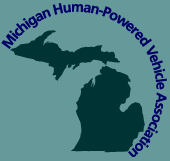By Mike Eliasohn
Us HPV old-timers remember McKinley Thompson Jr., who showed up at the Michigan HPV Rallies and other HPV events in the 1980s and early 1990s with some interesting vehicles he designed and built.
He likely is the only person to have created HPVs with two, three, four and five wheels.
I knew McKinley, who lived in Detroit, worked for Ford Motor Co., but I don’t remember if I knew what he did at Ford.
Then in February of this year, the Automotive Hall of Fame (automotivehalloffame.org) in Dearborn, announced six inductees for this year into its Hall of Fame, including:
McKinley Thompson is a 1956 graduate from Art Center College of Design and made history by becoming one of the first African American automotive designers. Upon graduation, he landed a dream job at Ford’s legendary Advanced Design Studio, and went on to spend the next 28-years of his career as a designer for Ford. He was pivotal in shaping some of the company’s most iconic consumer products ever– including the Thunderbird, Mustang and Bronco. His acumen and aesthetic left an indelible mark on the automotive world and his timeless designs have been studied by generations of automotive designers.
The other inductees will be Mary Barra, General Motors Corp. chairman and chief executive officer; five-time world Formula 1 champion Juan Manuel Fangio; Honda Motor Co. co-founder Takeo Fujisawa; Larry R. Wood, who designed Hot Wheels cars for 50 years; and Fred Bauer, founder of Gentex, manufacturer of auto-dimming rearview mirrors and automotive electronics.
The induction ceremony will be July 20 at the Fillmore in Detroit.
Here's Brooke racing Orca at the 4th annual Michigan HPV Rally on Aug. 9,1986 at Waterford Hills, the first rally held at the track in Clarkston. Brooke, from Northville, finished 6th overall and participants voted Orca "most popular" vehicle. There weren't different vehicle classes in 1986, so all 31 participants were, in essence, racing in the same class, regardless of age, sex or type of vehicle. Then from Aug. 26-29, he and McKinley were at the International Human Powered Speed Championships in Vancouver, British Columbia, Canada. Brooke and Orca finished 28th overall of 39 entries. He competed in the 200 meter flying start sprints (25.36 mph), 15-kilometer criterium and commuter vehicle event.
McKinley was born in 1922, grew up in Queens, New York, and had a keen interest in cars from when he was young, according to a Ford news release. “He served in the Army Signal Corps during World War II, learning drafting and working as an engineering layout coordinator. After the war, that work provided for him and his growing family, but Thompson’s love of cars and his dream of being a designer persisted.” In 1953, he entered a design contest in Motor Trend magazine, submitting a design for a gas turbine car with a reinforced plastic body,
He won the contest, the prize for which was a scholarship to the ArtCenter College of Design in Pasadena, Calif. After graduating with a degree in transportation design in 1956, he started working for Ford.
He retired from Ford in 1984 and eventually moved with his wife, Theresa, to Arizona, where he died in 2006 at age 83. (If you want to read more about McKinley and his automotive design career, type in “McKinley Thompson Jr.” in Google, Yahoo or other search engine and you will find several articles.)
Going through my photos and what I wrote on the backs and Michigan HPV Association newsletters, McKinley and one of his pedal-powered creations – a recumbent tricycle – first appeared at the 11th annual International Human Powered Speed Championships in Indianapolis in September 1985. (Photo at top of this article.)
This was Rolling Thunder at the Michigan HPV Rally at Waterford Hills in August 1987. It had single wheels front and rear, which was the drive wheel, and two outrigger wheels midway. Frame was made of aluminum tubing. Body was made of Lexan polycarbonate plastic, pop riveted together. With any vibration, the body panels rattled, hence the vehicle name. Rolling Thunder was selected "most popular entry."
The final time was at the Michigan HPV Rally at Waterford Hills in June 1993, where McKinley showed, but didn’t race his Eagle Duo, a side-by-side two rider tricycle (two wheels in front).
“At the end of his journey, that (developing HPVs) was his greatest passion,” she said.
When he and his wife moved to Sun City, Arizona, Buzzone said, he took a couple of his creations with him that were best suited for pedaling around in a senior citizen community.
She said the rest he sold or gave away, but doesn’t know if any still exist or who has them. (If anyone knows, please contact the author.)












No comments:
Post a Comment